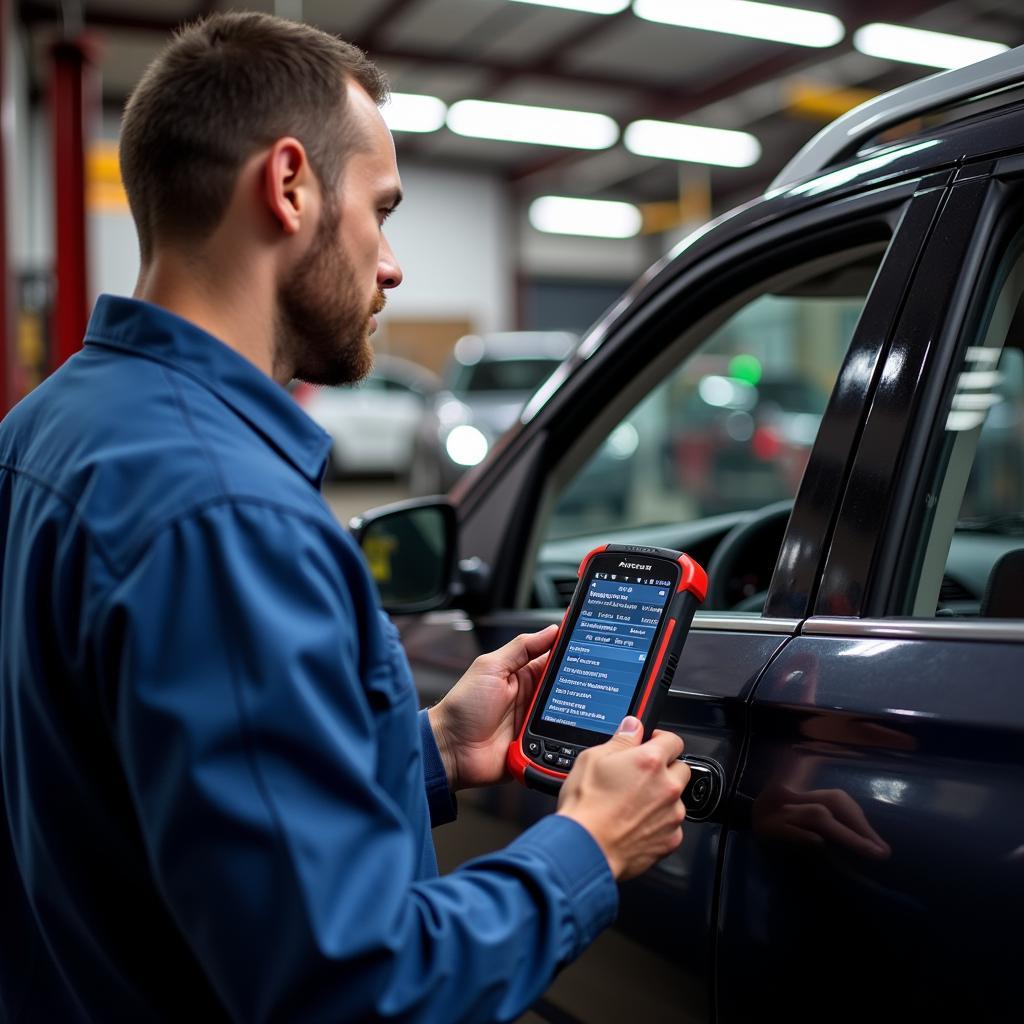The world of automotive technology has evolved significantly, moving away from wrenches and screwdrivers towards sophisticated software and electronic control units (ECUs). Modern vehicles are complex machines that require equally sophisticated Examples Of Diagnostic Tools to identify and repair issues. These tools provide a window into the inner workings of a vehicle, allowing technicians to diagnose problems accurately and efficiently.
One of the most significant advantages of modern diagnostic tools is their ability to communicate with a vehicle’s onboard computer systems. Academic diagnostic tools can read and interpret diagnostic trouble codes (DTCs), which are stored in the ECU’s memory. These codes act like breadcrumbs, pointing technicians towards the potential source of a problem.
Understanding Diagnostic Trouble Codes (DTCs)
DTCs are alphanumeric codes that correspond to specific vehicle systems and components. For example, a code like “P0301” indicates a misfire in cylinder number one. By deciphering these codes, technicians can quickly narrow down the potential causes of a problem.
[image-1|diagnostic-trouble-codes|Diagnostic Trouble Codes|A mechanic is using a diagnostic tool to read DTCs from a car’s onboard computer. The screen displays a list of codes, along with their descriptions.]
Types of Diagnostic Tools: From Basic to Advanced
The range of examples of diagnostic tools available today is vast, catering to various needs and budgets. Let’s explore some common types:
1. Code Readers: The Entry-Level Solution
Code readers are basic diagnostic tools that can read and display DTCs. They are an affordable option for DIY enthusiasts and small workshops, allowing users to identify potential issues quickly.
2. Scan Tools: Taking Diagnostics a Step Further
Scan tools offer more advanced features compared to code readers. They can not only read and clear DTCs but also display live data streams from various sensors. This data can be invaluable in diagnosing intermittent problems or monitoring system performance in real-time.
3. Oscilloscopes: Visualizing Electrical Signals
Oscilloscopes are powerful tools used to visualize electrical signals within a vehicle’s systems. They allow technicians to analyze waveforms and identify anomalies that might indicate faulty sensors, wiring issues, or other electrical problems.
[image-2|automotive-oscilloscope|Automotive Oscilloscope in Use|An automotive oscilloscope displays a waveform on its screen. A technician is using it to diagnose an electrical issue in a vehicle.]
4. Pressure Gauges: Essential for Fluid Systems
Pressure gauges are indispensable for diagnosing problems related to fluid systems, such as the braking system, fuel system, and cooling system. They allow technicians to measure pressure levels and identify leaks, blockages, or other issues.
5. Vacuum Testers: Diagnosing Engine Problems
Vacuum testers are used to measure vacuum pressure in the engine’s intake manifold. Fluctuations in vacuum pressure can indicate problems with components like the intake manifold gasket, EGR valve, or vacuum lines.
[image-3|vacuum-tester-engine|Mechanic Using a Vacuum Tester|A mechanic is connecting a vacuum tester to the engine of a car. The gauge on the tester will show the vacuum pressure.]
The Importance of Choosing the Right Tool
Selecting the appropriate diagnostic tools depends on several factors, including the type of vehicle, the complexity of the repair, and the budget.
“Investing in the right diagnostic tools is crucial for any modern automotive repair shop,” says John Smith, a veteran automotive engineer with over 20 years of experience. “These tools not only save time and effort but also ensure accurate diagnoses, leading to effective repairs and satisfied customers.”
Beyond Diagnostics: The Future of Automotive Repair
As technology continues to advance, we can expect even more sophisticated diagnostic tools to emerge. These tools will likely incorporate artificial intelligence (AI) and machine learning algorithms to provide even more accurate and efficient diagnoses.
For instance, AI-powered diagnostic tools could analyze vast amounts of data from various sources, including the vehicle’s history, real-time sensor data, and even online repair databases. This would allow them to not only identify the root cause of a problem but also predict potential future issues.
Conclusion
Examples of diagnostic tools have revolutionized the way automotive repairs are performed. These tools provide technicians with the insights they need to diagnose and repair complex vehicle systems accurately. As technology continues to evolve, we can expect even more innovative diagnostic tools to emerge, further enhancing the efficiency and accuracy of automotive repair.
If you are a car owner, a repair shop owner, or an aspiring automotive technician, investing in quality diagnostic tools is essential to keep pace with the evolving automotive landscape.
For expert advice on choosing the right diagnostic tools for your needs, contact ScanToolUS at +1 (641) 206-8880 or visit our office at 1615 S Laramie Ave, Cicero, IL 60804, USA.
FAQs
-
What is the difference between a code reader and a scan tool? While both tools can read DTCs, scan tools offer more advanced features, such as live data streaming, bi-directional control, and special functions.
-
Can I use diagnostic tools on any car? Most modern diagnostic tools are compatible with a wide range of vehicles. However, it’s always recommended to check the tool’s specifications and compatibility before purchase.
-
Do I need to be a mechanic to use diagnostic tools? While some diagnostic tools are designed for professional use, there are user-friendly options available for DIY enthusiasts as well.
-
How often should I use diagnostic tools on my car? It’s a good practice to scan your vehicle for DTCs periodically, even if you don’t experience any noticeable problems.
-
What should I do if my diagnostic tool shows a code I don’t understand? You can consult your vehicle’s service manual, online resources, or seek professional assistance from a qualified technician.


Pingback: Examples of Diagnostic Tools: A Comprehensive Guide - Car Scan Tool